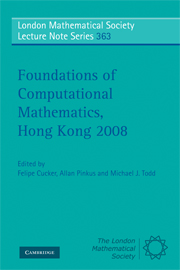Book contents
- Frontmatter
- Contents
- Preface
- Contributors
- 1 Smoothed Analysis of Condition Numbers
- 2 A World of Binomials
- 3 Linear and Nonlinear Subdivision Schemes in Geometric Modeling
- 4 Energy Preserving and Energy Stable Schemes for the Shallow Water Equations
- 5 Pathwise Convergence of Numerical Schemes for Random and Stochastic Differential Equations
- 6 Some Properties of the Global Behaviour of Conservative Low-Dimensional Systems
- 7 A Panoramic View of Asymptotics
- 8 Tractability of Multivariate Problems
1 - Smoothed Analysis of Condition Numbers
Published online by Cambridge University Press: 07 September 2011
- Frontmatter
- Contents
- Preface
- Contributors
- 1 Smoothed Analysis of Condition Numbers
- 2 A World of Binomials
- 3 Linear and Nonlinear Subdivision Schemes in Geometric Modeling
- 4 Energy Preserving and Energy Stable Schemes for the Shallow Water Equations
- 5 Pathwise Convergence of Numerical Schemes for Random and Stochastic Differential Equations
- 6 Some Properties of the Global Behaviour of Conservative Low-Dimensional Systems
- 7 A Panoramic View of Asymptotics
- 8 Tractability of Multivariate Problems
Summary
Abstract
The running time of many iterative numerical algorithms is dominated by the condition number of the input, a quantity measuring the sensitivity of the solution with regard to small perturbations of the input. Examples are iterative methods of linear algebra, interior-point methods of linear and convex optimization, as well as homotopy methods for solving systems of polynomial equations. Thus a probabilistic analysis of these algorithms can be reduced to the analysis of the distribution of the condition number for a random input. This approach was elaborated upon for average-case complexity by many researchers.
The goal of this survey is to explain how average-case analysis can be naturally refined in the sense of smoothed analysis. The latter concept, introduced by Spielman and Teng in 2001, aims at showing that for all real inputs (even ill-posed ones), and all slight random perturbations of that input, it is unlikely that the running time will be large. A recent general result of Bürgisser, Cucker and Lotz (2008) gives smoothed analysis estimates for a variety of applications. Its proof boils down to local bounds on the volume of tubes around a real algebraic hypersurface in a sphere. This is achieved by bounding the integrals of absolute curvature of smooth hypersurfaces in terms of their degree via the principal kinematic formula of integral geometry and Bézout's theorem.
Introduction
In computer science, the most common theoretical approach to understanding the behaviour of algorithms is worst-case analysis.
- Type
- Chapter
- Information
- Publisher: Cambridge University PressPrint publication year: 2009
- 1
- Cited by



